1. Pure Substance
- Books Name
- Science Made Easy Science Book
- Publication
- Science Made Easy
- Course
- CBSE Class 9
- Subject
- Science
Introduction
Anything which occupies space and has mass is called matter.
Matter can be divided in two categories.
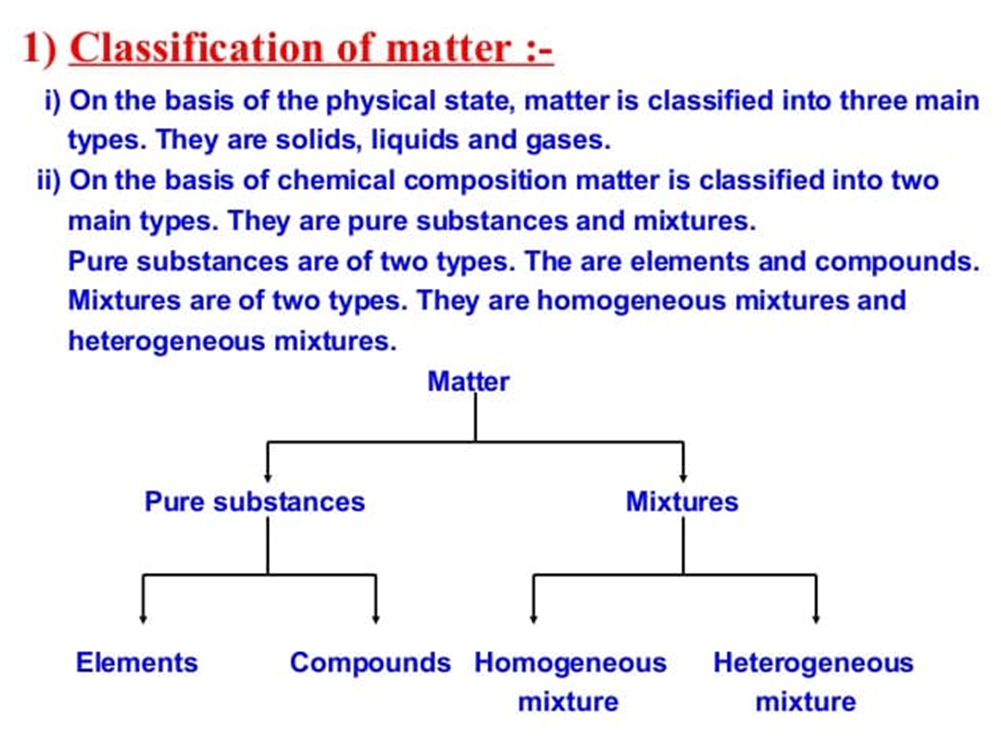
(i) Pure Substance: It consists of single types of particles which are same in their chemical nature.
(ii) Mixtures: Mixture consists of two or more particles.
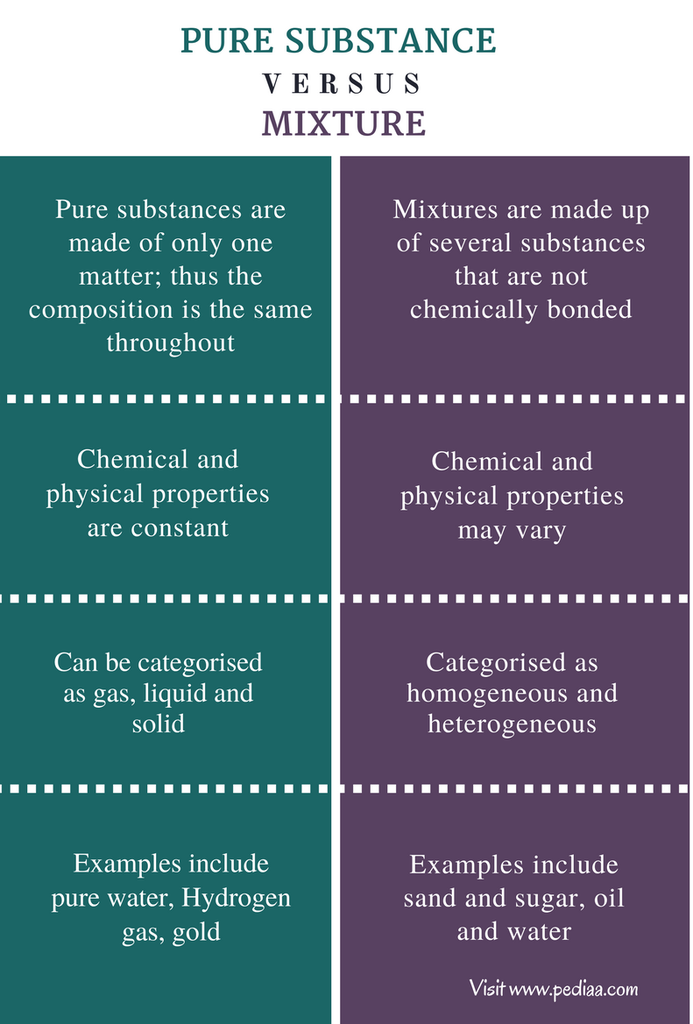
Mixture and its types
Mixture consists of more than one kind of pure substances which can be separated by physical method.
Mixtures are of two types
(i) Homogeneous mixture
(ii) Heterogeneous mixture
(i) Homogeneous mixture: A mixture is said to be homogeneous if all the components of the
mixture are uniformly mixed and there are no boundaries of separation between them.
Ex: Sugar in water, etc.
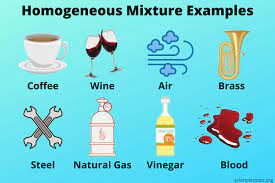
(ii) Heterogeneous mixtures: A mixture is said to be heterogeneous if all the components of the
mixture are not uniformly mixed and there are visible boundaries of separation between them
Ex: Water and sand, Air etc.
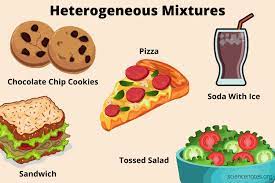
1. Pure Substance
Is Matter around us pure
Introduction
When we talk about pure, it means that all the constituent particles of that substance are the same in their chemical nature. A pure substance consists of a single type of a particles. What is the type of pure substances?
- Elements
- Robert Boyle A was the first scientist to use the term element in 1661.
- Antoine Laurent Lavoisier (1743–94), a French chemist, was the first to establish an experimentally useful definition of an element.
- Elements can be normally divided into metals, non – metals and metalloids.
Metals
- Metals usually show some or all of the following properties:
- They have a lustre (shine).
- They conduct heat and electricity.
- They are ductile (can be drawn into wires).
- They are malleable (can be hammered into thin sheets).
- They are sonorous (make a ringing sound when hit).
# Examples of metals are gold, silver, copper, iron, sodium, potassium etc.
# Mercury is the only metal that is liquid at room temperature.
Non metals
- Non – metals usually show some or all of the following properties:
- They are poor conductors of heat and electricity.
- They are not lustrous, sonorous or malleable.
# Examples of non – metals are hydrogen. oxygen, iodine, carbon (coal, coke). bromine, chlorine etc.
Metalloids
- Metallaoids have intermediate properties between of metals and non – metals.
# Examples are boron, silicon, germanium etc.
Mixture and compound
| Mixture | Compound |
| 1. Elements or compounds are simple calling so new substance is formed. Compound | 1. Substances Are Reated Together with each other to make a new substance. |
| 2. Elements do not combine in a fixed ratio. | 2. Compositions the the component is Fixed i.e. , They combine together in a fixed ratio according to their masses. |
| 3. A mixture shows the properties of its components | 3. compound does not show the Properties of component elements. |
| 4. Components can be easily separated by any mechanical method which is suitable. | 4. components can not be separated from each other by simple mechanical methods. |
1. Pure Substance
- Books Name
- Yash Tyagi Coaching Science Book
- Publication
- ACERISE INDIA
- Course
- CBSE Class 9
- Subject
- Science
Chapter-2
Is Matter around us Pure
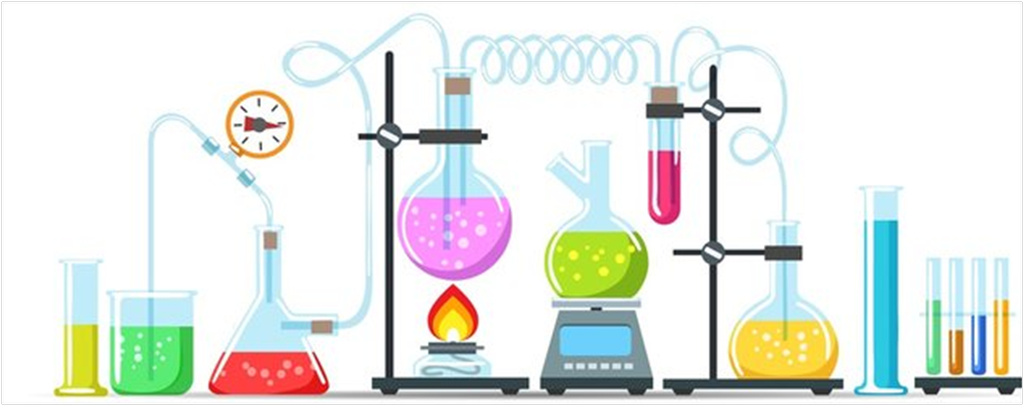
Is Matter around us Pure Introduction
We come across different substances like water that we drink; salt that we add in food for taste, milk that we drink as it provides us with calcium and other minerals, soaps that we use to wash clothes, paint that we use to colour walls and so on. These substances have different nature, different properties. They can be pure or there can be some impurities in them. Let us see what do we understand by the words pure or impure substance[12]
We come across different substances like water that we drink; salt that we add in food for taste, milk that we drink as it provides us with calcium and other minerals, soaps that we use to wash clothes, paint that we use to colour walls and so on. These substances have different nature, different properties. They can be pure or there can be some impurities in them. Let us see what do we understand by the words pure or impure substances[15]
We come across different substances like water that we drink; salt that we add in food for taste, milk that we drink as it provides us with calcium and other minerals, soaps that we use to wash clothes, paint that we use to colour walls and so on. These substances have different nature, different properties. They can be pure or there can be some impurities in them. Let us see what do we understand by the words pure or impure substances[20]
Pure substance
They are substances that are made up of a single type of particle. But there are certain characteristics that determine the purity of a substance. Let us see what all properties they possess.
Characteristics of a pure substance are as follows
1. They all have a uniform composition (homogeneous).
2. They can not be separated into their constituents.
3. They have fixed melting and boiling points.
4. They always have the same characteristic properties.

Two categories of substances fall under pure substance. They are as follows
1. Elements
2. Compounds
Element
As we know, an atom is the smallest particle that may or may not exist independently. These atoms unite together and form an element. This element can exist independently but it can not be broken into atoms as they are not visible. About 118 elements are known so far and still many discoveries are in the pipeline. Elements can be prepared artificially in lab, also by transmutation process. The elements having atomic number more than 92 are manmade and are called transuranic elements. An element is defined as a substance that can not be broken into simpler substances as it is formed of atoms and atoms can not be seen.
The characteristics of elements are as follows
1. They are made up of atoms
2. The physical & chemical properties of an element are due to the arrangement of atoms.
3. They can occur in nature in free or combined form.
4. They can be prepared artificially by nuclear reaction.
5. They can be solids, liquids (only 3) or gases (11) at normal room temperature.

Metals
In daily routine, we use a lot of substances that fall in this category like the vehicles which are usually made up of iron, furniture, utensils and many more. Let us see their properties. Those substances which have a tendency to lose electrons and form positively charged species, that is cation are called metals.
Na – 1e- → Na+ (cation)
2, 8, 1 2, 8
Physical properties of metals are as follows
- They are malleable like Al(aluminum), Ag(silver) [ except alkali metals that is Na,K,Li etc]
- They are ductile like Al, Ag, etc.
- They are lustrous (except – Hg(mercury), Cs(cesium), Ga (gallium)) .
- They are hard (except Na & K ).
- They are good conductors of heat & electricity.
- They have high melting and boiling points [except Na, k, Ca they have low boiling and melting point] .
- They are Sonorous (that is when hit, they produce a sound).
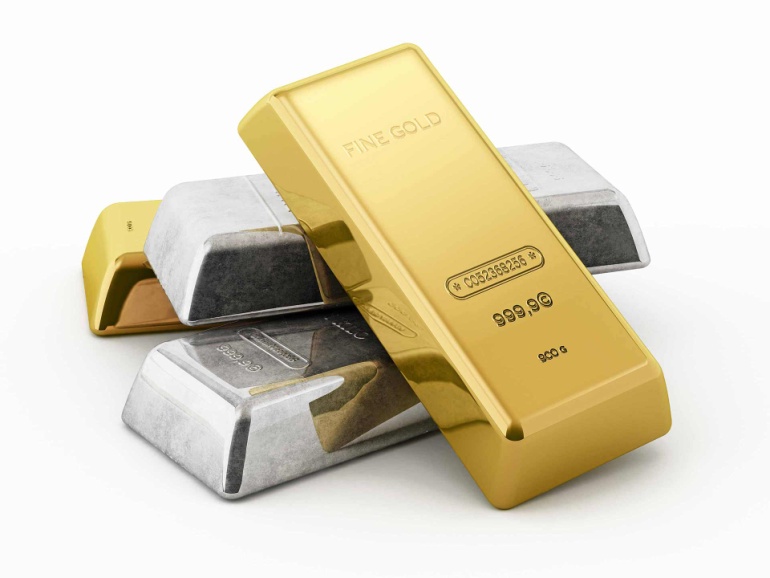
Chemical Properties of metals are as follows
1. Reaction with oxygen
Metals react with oxygen to form oxides.
M + O2 → Metal oxides
All Metal oxides are basic in nature i.e. they turn red litmus blue but some metal oxides are amphoteric in nature (that is, they have acidic & basic nature) like Al2O3 (aluminum oxide) & ZnO (zinc oxide).
2. Reaction with dilute acids
Metals react with dilute acids to form a salt and H2 gas.
M + HX → MX + H2
Example: Na + HCl → NaCl + H2
The hydrogen gas, when comes in contact with air, burns with a popping sound.
Non-Metals
Non – Metals are those elements that always gain electrons and form anions (negatively – charged ions).
Example: Cl + e- → Cl- anion
2, 8, 7 2, 8, 8
Physical properties of non – metals are as follows
- They are liquid or gases (only one exists in liquid form – that is Bromine) except C, S, P, I that are solids.
- They are non – malleable and non – ductile because to make wires or sheets, we need to hammer them, but as they are brittle, they break.
- They are bad conductors of heat and electricity (like graphite).
- They have low melting and boiling point (except B, C which have high melting and boiling points).
- They are non sonorous.
- They are non lustrous (except graphite and iodine).
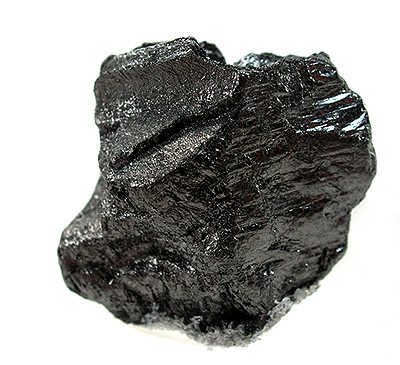
Chemical properties of non – metals are as follows
1. Reaction with oxygen
Non – metals react with O2 to form Non Metal oxide with respective formula as given below:
N + O2 → non metal oxide
They are acidic in nature and turn blue litmus red.
2. Reaction with dilute acids
Non metals do not react with die acids as they do not have sufficient electrons.
Metalloids
They are those which have properties similar to metals and non-metals. Few elements exist as Noble gases. They are those which are stable elements as they have a stable configuration and generally exist free in nature as they do not need to combine with other elements because they have a stable electronic configuration. The noble gases are He (helium), Ne (neon), Ar (Argon), Kr (krypton), Xe (xenon) and radon.
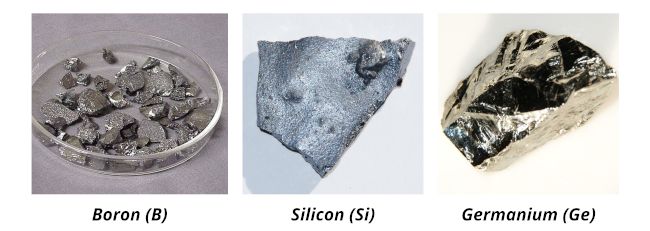
Compounds
We use so many compounds like salt, water, fertilizers, etc. Let us learn about their properties. They are formed when 2 or more elements combine in a fixed whole number ratio. Example: H2O (water), NaCl (sodium chloride), etc.
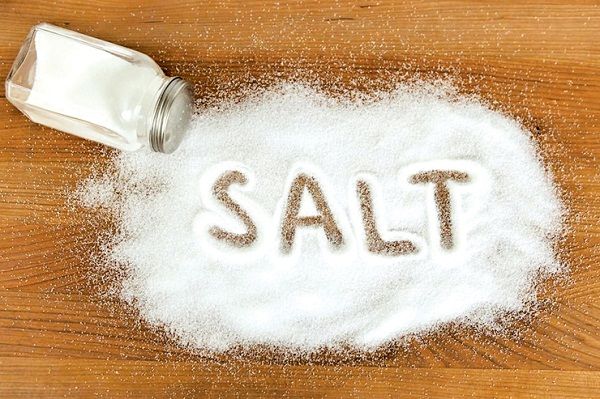
Characteristics of compounds are as follows
- They are homogenous.
- The properties of a compound are entirely different from its constituents.
- The constituents can not be separated by physical methods.
- They have fixed properties like Melting point and Boiling point.
- The formation of compound is accompanied by energy changes.
2. Impure Substance
- Books Name
- Science Made Easy Science Book
- Publication
- Science Made Easy
- Course
- CBSE Class 9
- Subject
- Science
Solution and its properties
A solution is a homogeneous mixture of two or more substances. Ex: Lemonade, soda water etc
A solution has two components:
(i) Solvent
(ii) Solute
(i) Solvent: The component of the solution that dissolves the other component in it (usually the component present in larger amount) is called the solvent.
(ii) Solute: The component of the solution that is dissolved in the solvent (usually present in less quantity) is called the solute.
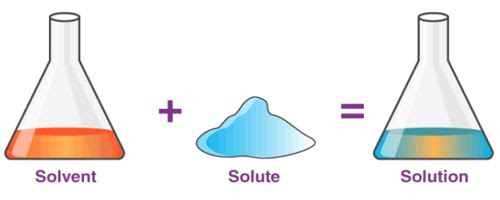
Properties of Solution:
1. A solution is a homogeneous mixture.
2. The particles of a solution are smaller than 1 nm
(10-9 ) in diameter which cannot be seen by naked
eyes.
3. They do not scatter a beam of light passing through the solution that is they don’t show tyndall effect. So, the path of light is not visible in a solution.
4. The solute particles cannot be separated from the mixture by the process of filtration.
5. The solution is stable and solute particles do not settle down when left undisturbed.
Concentration of a solution
(i) Saturated solution: When no more amount of solute can be dissolved in a solution at a give temperature, it is called a saturated solution.
(ii) Unsaturated solution: When more amount of solute can be dissolved in a solution at a give temperature, it is called a saturated solution.
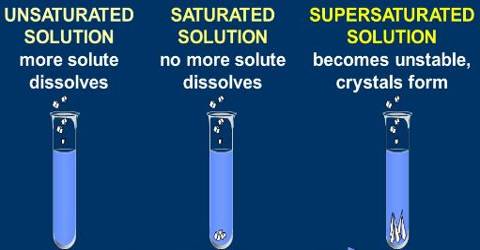
(ii) Solubility: The amount of the solute present in the saturated solution at the given temperature
called its solubility.
The concentration of a solution is the amount of solute present in a given amount (mass or volume) of solution. Also, the amount of solute dissolved in a given mass or volume of solvent is called concentration of solution.
Concentration of solution = Amount of solute/Amount of solvent or Amount of solute/Amount in
solution (Here, amount means mass or volume).
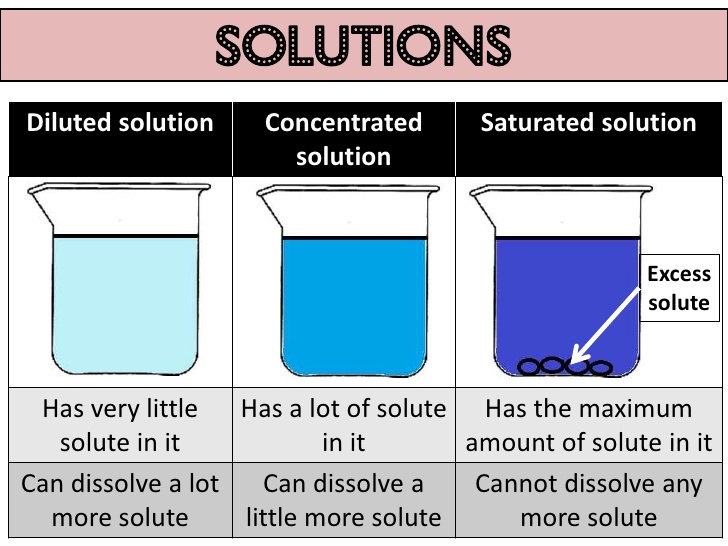
Two methods of finding concentration of solution:
(i) Mass by mass percentage of a solution = (Mass of solute/Mass of solution) ×100
(ii) Mass by volume percentage of a solution = (Mass of solute/Volume of solution) ×100
2. Impure Substance
But when we see around us, we observe most of the matter around us exists as mixtures of two or more pure components. For example: Sea water, Air etc.
WHAT IS A MIXTURE?
It is a form of matter in which two or more elements or compounds combine physically in any proportion by weight.
Characteristics of Mixture
- Mixture may be homogeneous and heterogeneous.
- Mixture does not have a fixed melting point.
- In a mixture, the different constituents combine physically in any proportion by mass.
- The constituents of a mixture do not lose their identical property.
- Usually, no energy change take place during the formation of a mixture.
Types of Mixtures
- Homogeneous mixture: A mixture which has same composition throughout. It has no visible boundaries of separation between the various constituents Solutions are homogeneous mixtures. For example, Detergent in water, Sugar in water, Ice cream etc.
- Heterogeneous mixture: A mixture which has different compositions in different parts. These types of mixtures have visible boundaries of separation between the various constituents. For example, Oil in water, Fruit salad, Sand in water etc.
2. Impure Substance
- Books Name
- Yash Tyagi Coaching Science Book
- Publication
- ACERISE INDIA
- Course
- CBSE Class 9
- Subject
- Science
Impure substance
The substances that are formed by different kinds of particles are called impure substances. For example : Mixtures are impure substances.
Mixtures
You must have eaten pakoras at home. Have you noticed how your mother prepares it. She makes a batter containing besan, water, spices, etc. These constituents can be added in any ratio. In all ratios, they will form pakoras but the difference will be that sometimes, they will be hard to touch or the batter may be too loose to fry.
Mixtures: They are formed when two or more substances are simply mixed in any ratio and are not chemically combined with each other.
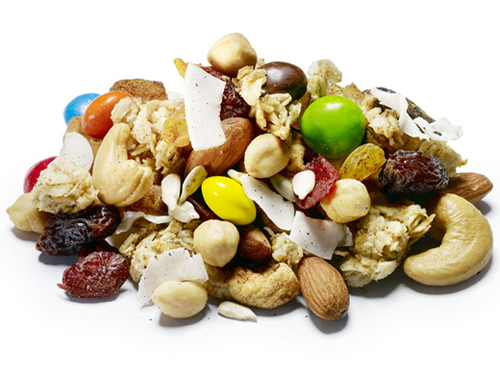
Characteristics of a mixture are as follows
- They can be homogeneous or heterogeneous in nature, that is, the constituents can be seen to have visible boundaries or they may appear to mix thoroughly.
- The properties of a mixture are the same as that of its constituents.
- The constituents can be separated by physical methods.
- Their formation does not require or release energy as there is no bond formation or breakage involved.
- The properties of mixtures like melting point & boiling point are not fixed.
Types of Mixtures
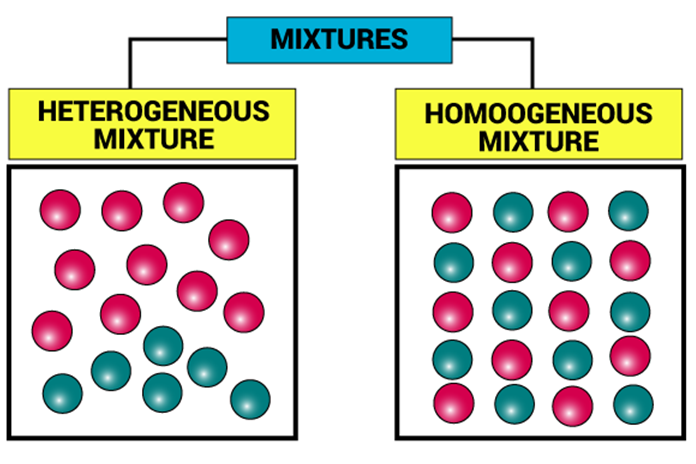

Solutions
We all like drinking sweet lemon water in summers as it gives a cooling effect. It is made of lemon, water, ice, salt and sugar. These all components when mixed, form sweet lemon water mixture which is also called a solution. These components can be separated by using different techniques. Let us learn what exactly solutions are and their types.
A Solution is a homogenous mixture of two or more substances. To form it, we can add 2 or more components. These components can be in any ratio but are simply mixed, that is not chemically combined. Generally, two components of solutions are seen and are called ‘Solute’ and ‘Solvent’.
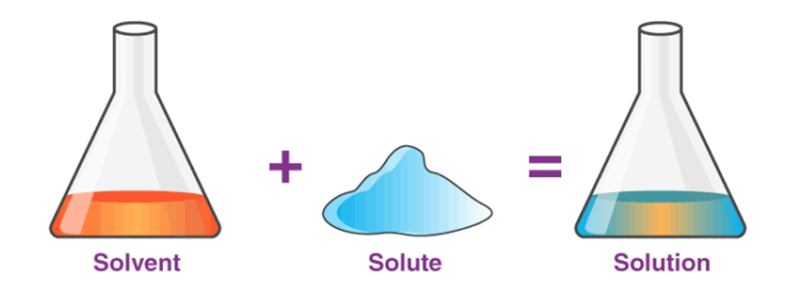
Solute
It is the constituent which is present in a comparitively lesser amount and gets dissolved in the solvent.
Solvent
It is the constituent present in more amount and it has the ability to dissolve the solute in it. If you dissolve salt in water, then the salt is in lesser quantity and it gets dissolved. So, here solute is salt and solvent is water
Characteristics of solutions are as follows
- They are homogeneous.
- Their Composition can vary.
- The size of particles is very small.
- They do not scatter light.
- They can be separated by physical methods.
Types of solutions
1. On the basis of dissolving nature of liquids
You must have noticed that when you dissolve sugar or salt in water, it just vanishes after a few seconds or a minute. The reason is that it gets mixed in water. But if we add oil in water, it does not vanish and is seen floating on its surface. It is due to this reason that some substances can mix into each other and some do not. Let us learn about it in detail
Miscible, immiscible & partially miscible solutions
Miscible liquids
The liquids that completely mix into each other to form a solution are miscible liquids. For example: alcohol when added to water gets completely mixed.
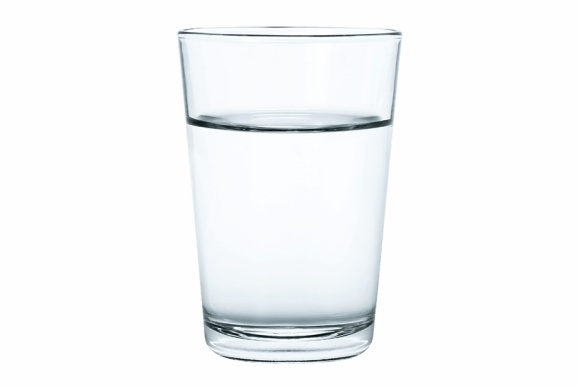
Partially miscible liquids
The liquids which can dissolve in another liquid only up to some extent to form a solution are partially miscible liquids. For example: ethylene glycol in chloroform.
Immiscible liquids
The liquids which do not mix into each other are immiscible liquids. For example: oil & water.
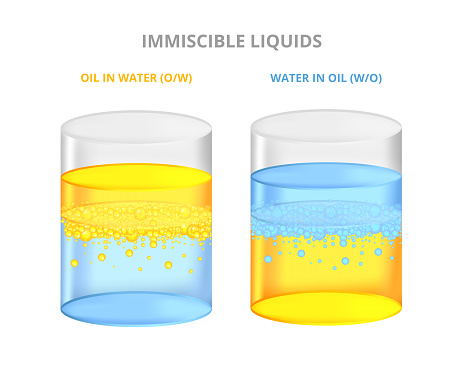
2. On the basis of nature of solvent
We have seen that it’s not only water in which we can dissolve substances, we can make use of other substances as well. For example- carbon tetrachloride, Benzene, alcohol, etc. and many more reagents. So, we have another classification based on the nature of solvent.
Aqueous and Non aqueous solutions
Aqueous
The solution in which the solvent is water is an aqueous solution. Example: salt solution
Non-aqueous solutions
The solution in which the solvent is other than water is a non-aqueous solution. Example: alcohol, benzene etc.
3. Classification on the basis of solubility power of solvent
You must have seen that if you take one glass of water at room temperature and you add 1 spoon of sugar to it, it dissolves. But if you keep on adding sugar to the same solution, a point will be reached when it stops dissolving sugar in it and the sugar starts getting deposited at the bottom. The reason being that each solvent has some solubility power and it can dissolve only up to that limit. Let us study about it.
Saturated, unsaturated and supersaturated solutions
Saturated Solution
The solution that dissolves as much solute as it is capable of dissolving is a saturated solution.
Unsaturated solution
The solution in which more quantity of solute can be dissolved without increasing its temperature is an unsaturated solution.
Supersaturated
The solution in which the solvent dissolves an amount of solute greater than its solubility. It is formed at high temperature and then slowly cooling it to lower its solubility.
Solubility
Is the amount of solute that can be dissolved in a given amount of solvent at a particular temperature.
Factors affecting solubility
- Nature of solute.
- Nature of solvent.
- Temperature.
Please Note:
- On lowering temperature, solubility of liquids & solid decreases & solubility of gas remains unaffected.
- On increasing pressure, solubility of gas increases & for solid and liquid, it remains unaffected.
4. Classification on the basis of size of solute particles
You must have made a solution of sand in water, sugar in water and milk. They don’t look the same. Let us predict the nature of these solutions
Difference between a true solution, colloid and a suspension
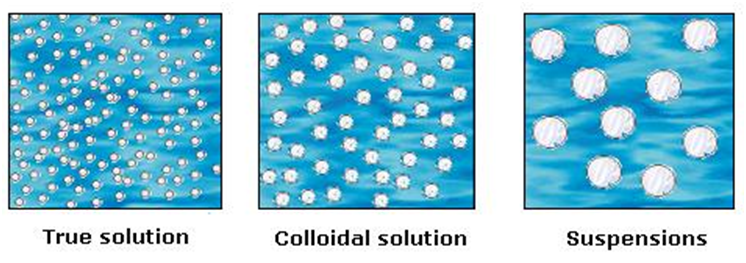
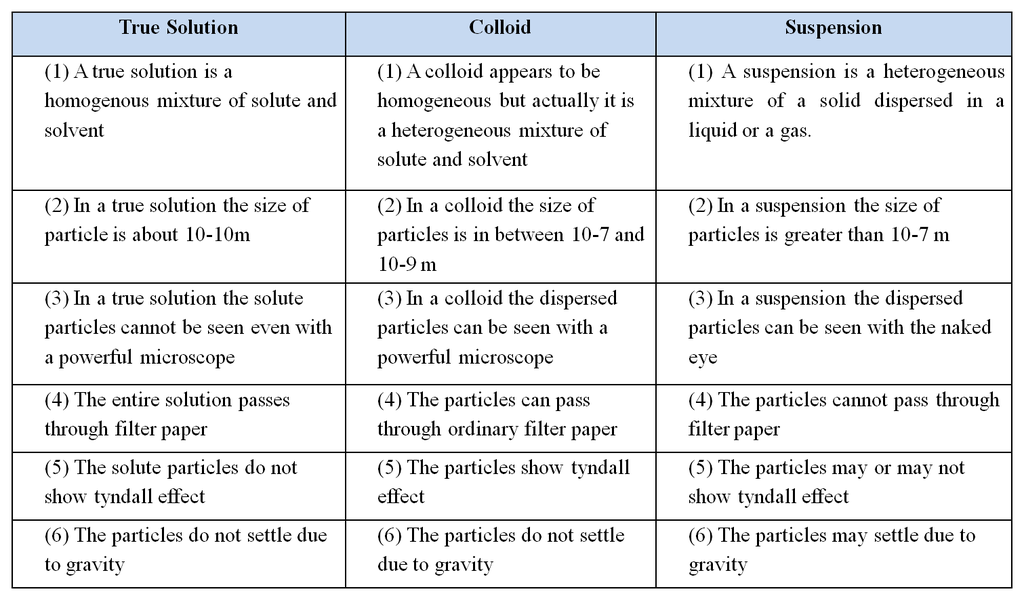
3. Separation of Mixtures
- Books Name
- Science Made Easy Science Book
- Publication
- Science Made Easy
- Course
- CBSE Class 9
- Subject
- Science
Suspension and its properties
A suspension is a heterogeneous mixture in which the the solute particles do not dissolve but
remain suspended throughout the bulk of the medium. Ex: Chalk in water, smoke in the air.
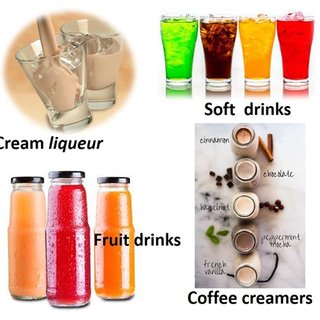
Properties of Suspension :
1. It is a heterogeneous mixture.
2. Particles of a suspension are visible to the naked eye.
3. Size of the particles is greater than 100 nm.
4. It is unstable mixture. Solute settles down at the bottom over period of time.
5. If the solution is passed through filter paper, solute and solvent gets separated.
6. It scatters light when light is passed through the solution i.e. it shows Tyndall effect.
3. Separation of Mixtures
WHAT IS SOLUTION?
A solution is a homogenous mixture of two or more substances. E.g. Nimboo pani, Soda water. A solution has a solvent and a solute as its components.
Solvent: The component of the solution that dissolves the other component in it is called the solvent.
Solute: The component of the solution that is dissolved is called the solute. in the solvent
Alloys: They are the mixtures of two or more metal or a metal and a non-metal and cannot be separated into their components by physical methods.
![]()
Properties of a Solution
• A Solution is a Homogeneous mixture.
• The particles of a solution are smaller than 1nm (10^-9 Metre) in Diameter. They cannot bean by Naked eyes.
• They are of very Small Particle Size, so they do not scatter a beam of lighting passing through the solution.
• The Solute Particles Cannot be separated from the mixture by the process of filtration.
Concentration of a solution
• Saturated solution: Depending upon the amount of solute present in a solution, it can be called a dilute, concentrated or a saturated solution.
• Unsaturated solution: If the amount of solute contained in a solution is less than the saturation level, it is called an unsaturated solution.
• Solubility: The amount of the solute present in the saturated solution at this temperature is called its solubility.
• The concentration of a solution is the amount of solute present in a given amount (mass or volume) of solution, or the amount of solute dissolved in a given mass or volume of solvent.
• Concentration of solution = Amount of solute / Amount of solution
Or
Amount of solute / Amount of solvent
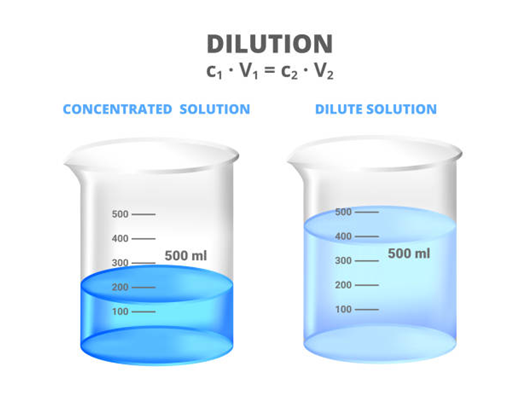
Ways of expressing the concentration of a solution
• Mass by mass percentage of a solution
Mass of solute / Mass of solution x100
• Mass by volume percentage of a solution
Mass of solute / Volume of solution x100
3. Separation of Mixtures
- Books Name
- Yash Tyagi Coaching Science Book
- Publication
- ACERISE INDIA
- Course
- CBSE Class 9
- Subject
- Science
Separation of Mixtures
1. To obtain colored component (dye) from Ink
Materials Required: Watch glass, Ink (blue/ black), Beaker, Stand, Burner
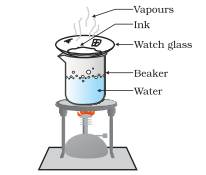
Procedure
1. Take a beaker and fill it half with water.
2. Take few ml of ink (Blue/ black) in the watch glass and place it on the mouth of the beaker.
3. Start heating the beaker and observe.
4. Heating is continued as long as the evaporation is taking place
5. Heating is stopped when no further change can be noticed on the watch glass
Observation
1. Evaporation taking place from the watch glass can be seen
2. Residue is left on the watch glass
Conclusion drawn
1. It can be concluded that,” Ink is not a pure substance but it is a mixture of dye in water which can easily be separated by evaporation method”.
2. Ink is not a single substance
3. Evaporation taking place from the watch glass containing ink.
Applications of evaporation process are as follows
1. This method can be used to separate the volatile component (solvent) from its non-volatile solute.
2. To obtain common salt from sea water. Sea water is trapped in small shallow pits (called lagoons) and is allowed to stand there for a few days. During this time the heat of the Sun evaporates water in these pits leaving behind the solid salt. This salt is further purified by crystallization method which you will study in the later part of this chapter.
2. To separate cream from milk by using centrifugation method.
Materials Required: Full cream milk, Centrifuging machine/milk churner, Jug test-tubes
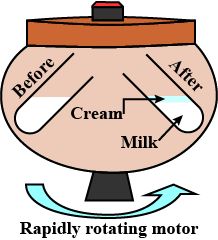
Procedure
1. Take un boiled cold milk in two test-tubes and place these test-tubes in a centrifuging machine .
2. Centrifuge it at high speed by using a hand centrifuging machine for two minute and observe.
Note: If you don’t have centrifuging machine in your school then you can do this activity by using a milk churner used in the kitchen.
Observation:
Cream floating on the milk can be seen
Conclusion drawn:
When milk is rotated at high speed, then the suspended lighter particles (fats and protein molecules) bind with each other forming ‘cream’ and ‘skimmed milk’. The cream being lighter, floats over the skimmed milk which can be removed easily.
Applications of centrifugation method are as follows
1. This technique is used in washing machines to squeeze out water from wet clothes and make them dry.
2. This technique is used in diagnostic laboratories for testing cholesterol lipids in blood, ESR (Erythrocyte Sedimentation Rate) and various other types of tests.
3. It is used in dairies for separating cream from milk and butter from curd.
3. To separate kerosene oil from water by using a separating funnel.
Materials Required: Separating funnel, Iron stand, kerosene oil, Beaker, Water.
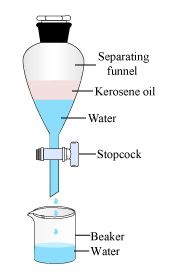
Procedure
1. A mixture of kerosene oil and water is taken in a separating funnel. The separating funnel is clamped on an iron stand.
2. The mixture is allowed to stand so that it forms two distinct layers.
3. A clean beaker is placed below and the stop cock is opened slowly so that water falls into the beaker.
4. Close the stop- cock of the separating funnel as the oil reaches the stop cock.
Observation:
Kerosene oil being lighter forms the upper layer.
Conclusion drawn:
When a liquid mixture containing two immiscible liquids is taken in a separating funnel, then the liquid layers stand one above the other. The liquid layer with greater density forms the lower layer whereas the lighter liquid (having lower density) forms the upper layer.
Applications of this method are as follows
1. They separate mixture of oil and water.
2. In the extraction of iron from its ore, the lighter slag is removed from the top by this method to leave the molten iron at the bottom in the furnace.
4. To separate a mixture of common salt and ammonium chloride
Materials Required: China dish, Tripod stand, Mixture of common salt and ammonium chloride, Glass funnel, Cotton, Burner.
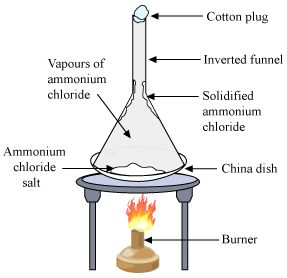
Procedure
1. Take the mixture of sand and ammonium chloride in a china dish.
2. Cover the china dish with an inverted glass funnel and place it on a tripod stand.
3. Put a loose cotton plug in the opening of the funnel so as to prevent the escape of ammonium chloride vapours.
4. Heat the china dish on a low flame and observe.
Observation
1. White fumes (vapours) of ammonium chloride can be seen coming out of the mixture.
2. These white fumes start depositing as white solid, on coming in contact with the cold, inner walls of the funnel.
3. Sand salt is left behind in the china dish.
Conclusion drawn:
Ammonium chloride, being a volatile substance, changes into white vapours easily which deposit on the cold inner wall of the funnel. This ammonium chloride obtained and is called as Sublimate. Some other examples of solids which sublime are: Iodine, camphor, naphthalene and anthracene.
5. To separate the dyes (colored components) present in black ink.
Materials Required: Strip of filter paper, Water soluble ink ( sketch pen or fountain pen), Large size glass jar with lid, Cotton, Thread.
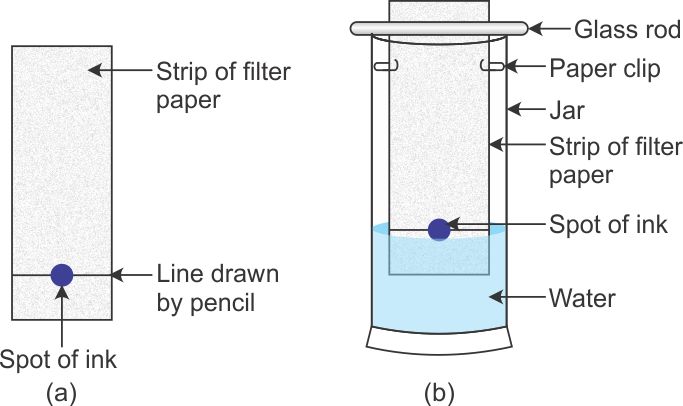
Procedure
1. Take a thin strip of filter paper (25cm x 5cm approx).
2. Draw a line on it using a pencil, approximately 3cm above the lower edge.
3. Put a small drop of water soluble black ink from a sketch pen or fountain pen) at the centre of the line. Let the ink dry.
4. Attach the paper strip on the thread with the help of cello tape.
5. Lower the filter paper strip into a large size gas jar in such a way that the drop of ink on the paper is just above the water level.
6. Adjust the thread and fix it on the sides of gas jar with the help of cello tape.
7. Cover the gas jar with a lid and leave it undisturbed.
8. Watch carefully as the water rises up on the filter paper.
9. Remove the filter paper strip, dry it and observe.
Observation:
Three colored spots can be seen on the filter paper strip.
Conclusion:
The given sample of black ink has three different dyes mixed in it.
6. To separate a mixture of two miscible liquids (acetone and water).
Materials Required: Distillation flask, Thermometer, Condenser, Beaker, Iron stand, Mixture of acetone and water.
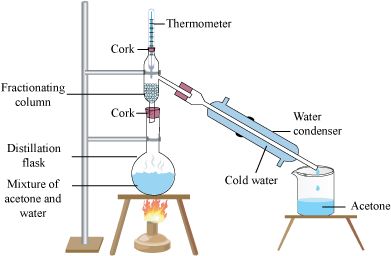
Procedure
1. Take the mixture in a distillation flask. Fit the flask with a thermometer.
2. Arrange the apparatus as shown in the figure.
3. Heat the mixture slowly, keeping a close watch at the thermometer and observe what happens.
Observation
1. The vapours of acetone can be seen rising up in the distillation flask with the increase in temperature.
2. When the temperature rises above 60o, the acetone gets vapourized and forms vapours in the flask.
3. These vapours get condensed in the condenser and can be collected (as pure liquid distillate) from the condenser outlet.
Result
Acetone can be collected in the beaker from the condenser outlet while water is left behind in the distillation flask.
7. To obtain crystals of pure copper sulphate salt from an impure sample by crystallization method.
Materials Required: Impure sample of copper sulphate, Beaker, China dish, Glass rod.
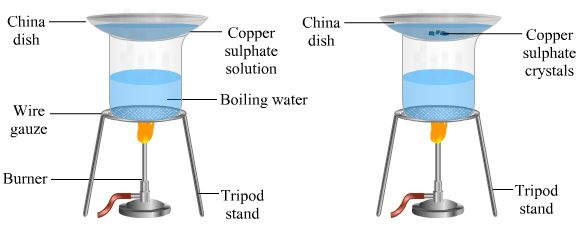
Procedure
1. Take about 5 grams of impure sample of copper sulphate in a china dish.
2. Dissolve it in minimum amount of water.
3. Filter the copper sulphate solution to remove the insoluble impurities.
4. Heat the copper sulphate solution gently on a water bath until it becomes saturated and reaches its crystallization point.
5. Crystallization point can be checked by taking some solution on a glass rod and waving it in the air. When a solid film (small crystals) is formed on the glass rod, then further heating is stopped. This indicates that the solution has been concentrated to crystallization point.
6. Place the china dish on the table after covering it with a watch glass. Leave it undisturbed at room temperature to cool slowly for a day and observe thereafter.
Observation
Crystals of copper sulphate can be seen in the china dish along with the mother liquor (the residual liquid which is left after crystallization).
Conclusions drawn
Hot and concentrated solution of any pure substance forms crystal on cooling gradually.
Result:
Pure crystals of copper sulphate are separated from the mother liquor. These crystals are dried further between the folds of a filter paper or on a porous plate.
8. Purification of surface water
The purification of surface water can be done through following steps
Sedimentation → loading → filtration → chlorination.
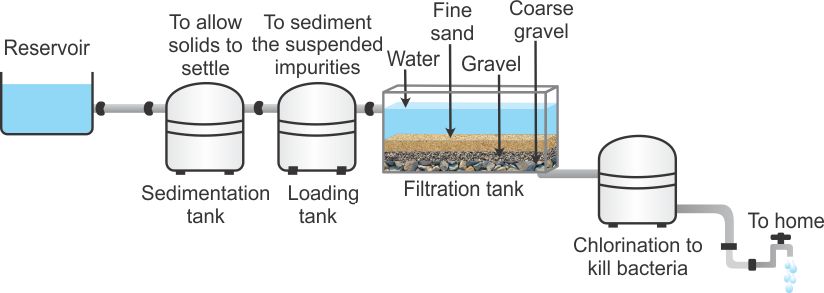
1. Sedimentation: The river water is pumped into a series of sedimentation tanks where it is allowed to stay for a day. Heavy particles of clay and other impurities settle down at the bottom due to the effect of gravity. The supernatant water is then sent to another settling tank.
2. Loading: In next chamber, water is treated with chemicals, i.e. alum and lime to get further settling of impurities.
3. Filtration: The clear water from the second tank is pumped into filtration tank where sand and gravel filter completely remove the suspended impurities.
4. Chlorination: The clear water is chlorinated with a calculated amount of chlorine in the chlorination tank. This process kills harmful bacteria and germs and provides safe drinking water.
4. Physical And Chemical Changes
- Books Name
- Science Made Easy Science Book
- Publication
- Science Made Easy
- Course
- CBSE Class 9
- Subject
- Science
Colloidal solution and its properties
Colloid solution is heterogeneous mixture in which the size of particles lies between the true solutions and suspensions.
• Colloidal particles can easily scatter a beam of visible light. This phenomenon is called
Tyndall effect.
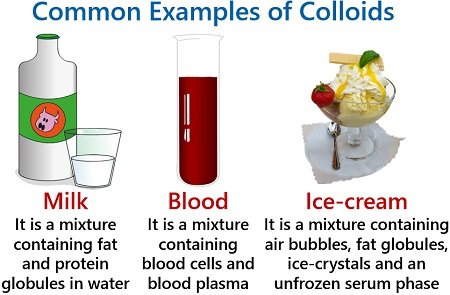
Properties of colloidal solution:
1. The particles of colloid can’t be seen by naked eyes individually.
2. It is a heterogeneous mixture and thus solute and solvent can’t be separated by filter paper.
3. Size of particles is smaller than suspensions but greater than solutions (1 nm to 100 nm).
4. It is a stable mixture. Particles do not settle down at the bottom over a period of time.
5. They do not settle down when left undisturbed which means colloid is quite stable.
Some common examples of colloids (in the table)
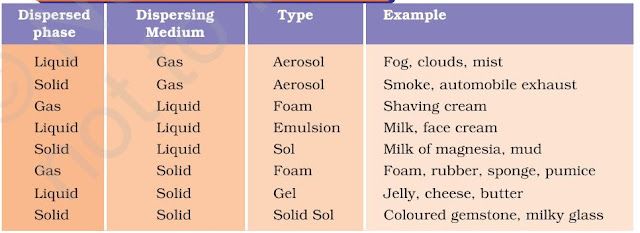
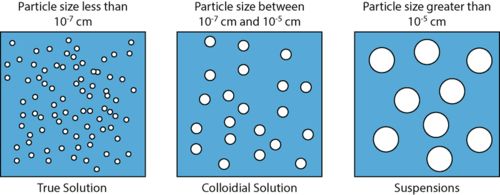

4. Physical And Chemical Changes
What is a suspension?
In which solids are dispersed in liquids, are called suspensions.
A suspension is a heterogeneous mixture
Particles of a suspension are visible to the naked eye.
Properties of a Suspension
• Suspension is a heterogeneous mixture.
• The particles of a suspension can be seen by the naked eye.
- The particles of a suspension scatter a beam of light passing through it and make its path visible.
• The solute particles settle down when a suspension is left undisturbed, that is, a suspension is unstable.
WHAT IS A COLLOIDAL SOLUTION?
A colloidal solution is a heterogeneous mixture, for example, milk.
Because of the small size of colloidal particles, we cannot see them with naked eyes.
These particles can easily scatter a beam of visible light.
Tyndall effect
The scattering of a beam of light is called the Tyndall effect
The Tyndall effect can also be observed when a fine beam of light enters a room through a small hole.
This happens due to the scattering of light by the particles of dust and smoke in the air.
Observation of Tyndall effect
The Tyndall effect can be observed when sunlight passes through the canopy of a dense forest.
Properties of a colloid.
A colloid is a heterogeneous mixture.
The size of particles of a colloid is too small to be individually seen by naked eyes.
Colloids are large enough to scatter a beam of light passing through it and make its path visible.
They do not settle down when left undisturbed, that is, a colloid is quite stable.
They cannot be separated from the mixture by the process of filtration.
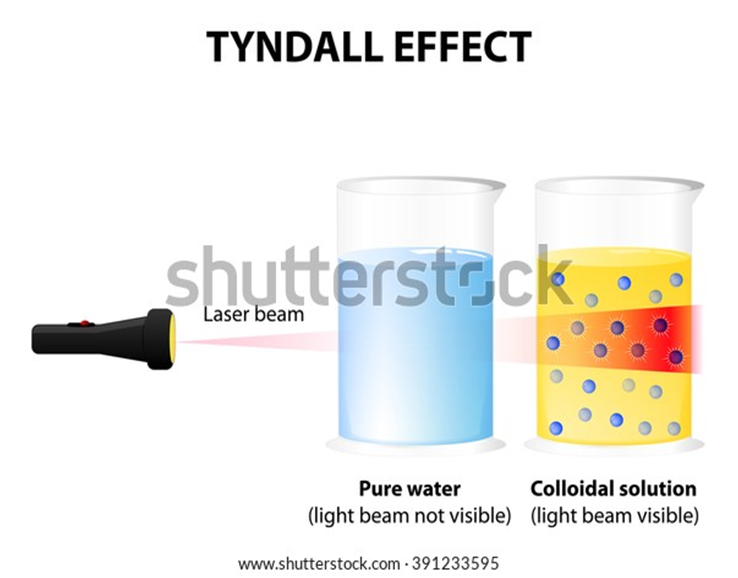
Dispersing medium
The components of a colloidal solution are the dispersed phase and the dispersion medium.
The solute – like component or the dispersed particles in a colloid form the dispersed phase, and the component in which the dispersed phase is suspended is known as the dispersing medium.
4. Physical And Chemical Changes
- Books Name
- Yash Tyagi Coaching Science Book
- Publication
- ACERISE INDIA
- Course
- CBSE Class 9
- Subject
- Science
Physical and chemical Change
We observe different kind of changes around us like if you forget to keep the milk inside the fridge in summers it gets rancid, likewise when you keep ice out of the refrigerator, you observe the water around it and finally the ice gets converted into water. These all are changes that are taking place around us. But some changes can be reversed like water can be converted back to ice but rancid food item can not be made fresh again. Let us learn in detail about these changes.
1. Physical change
2. Chemical change
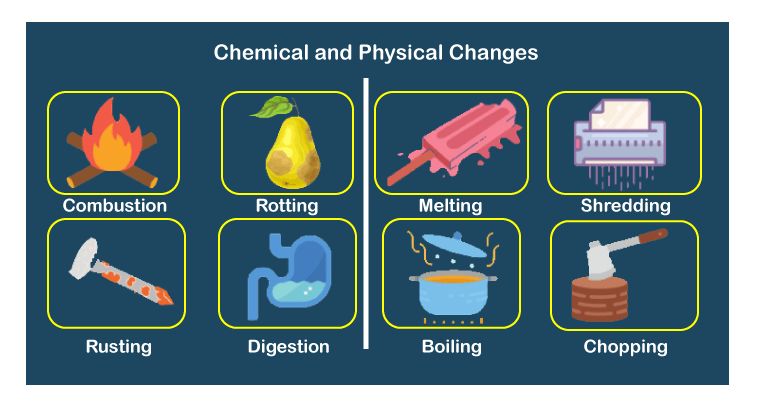

5. What Are The Types Of Pure Substances ?
- Books Name
- Science Made Easy Science Book
- Publication
- Science Made Easy
- Course
- CBSE Class 9
- Subject
- Science
Separation of the components of mixtures
Different methods of separation are used to get from mixture.
Heterogeneous mixtures can be separated into their respective constituents by simple physical
methods like handpicking, sieving, filtration etc.
Obtaining coloured components from blue/black ink
Process of evaporation is used to obtain coloured components from blue/black ink. The process of
evaporation is used to separate a substance which is dissolved in water.
• It is based on the fact that liquid vaporises easily than the solid.
• Helps in separating volatile substances from non-volatile substances.
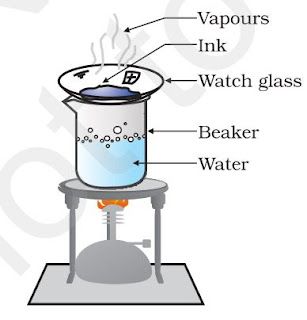
Steps of obtaining coloured components from blue/black ink:
• Fill half a beaker with water.
• Put a watch glass on the mouth of the beaker.
• Put few drops of ink on the watch glass.
• Now start heating the beaker. We do not want to heat the ink directly. You will see that evaporation
is taking place from the watch glass.
• Continue heating as the evaporation goes on and stop heating when you do not see any further
change on the watch glass.
Separation of cream from milk
• The process of centrifugation is used to separate the cream from milk. It is a method of separating
the suspended particles of substance from a liquid.
• This process is carried out by the machine called centrifuge.
• Sometimes, the solid particles in a liquid are very small and pass through a filter paper. For that
particles the filtration technique cannot be used.
• The mixture is rotated rapidly so that the heavier particles in the mixtures settle down to the
bottom.
• The basic principle of centrifugation is that the denser particles are forced to the bottom and
liquid being lighter remains at the top.
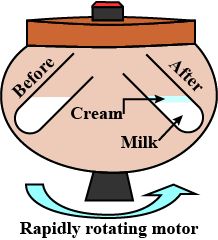
Steps of separating cream from milk:
• Take some full-cream milk in a test tube.
• Centrifuge it by using a centrifuging machine for two minutes.
Application of centrifugation:
• Used in diagnostic laboratories for blood and urine tests.
• Used in dairies and home to separate butter from cream.
• Used in washing machines to squeeze out water from wet clothes.
Separating two immiscible liquids
• The separation of separating two immiscible liquid is carried out by the use of funnel.
• The basic principle involve is the difference between the densities of two liquids form two separate layers.
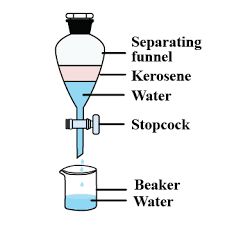
Steps of separating kerosene oil and water:
• Pour the mixture of kerosene oil and water in a separating funnel.
• Let it stand undisturbed for sometime so that separate layers of oil and water are formed.
• Open the stopcock of the separating funnel and pour out the lower layer of water carefully.
• Close the stopcock of the separating funnel as the oil reaches the stop-cock.
Application of funnel:
• To separate mixture of oil and water.
• In the extraction of iron from its ore, the lighter slag is removed from the top by this method to
leave the molten iron at the bottom in the furnace.
Sublimation
• This process is used to separate mixtures that contain a sublimable volatile component from
non-sublimable impurity.
• Sublimation is process where a substance directly changes from solid to gaseous state on heating.
• Ammonium chloride, camphor, naphthalene and anthracene are some examples which can be
sublime.
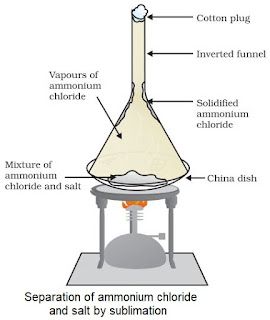
Chromatography
• Used to separate those solutes which dissolve in the same solvent.
• Used for sepration of colours.
• The colours which are more soluble in water rises faster.
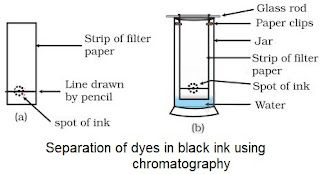
Applications
To separate
• colours in a dye
• pigments from natural colours
• drugs from blood.
Distillation
• Used for separation of components of a mixture containing two miscible liquids that boil with the
decomposition and have sufficient difference in their boiling points.
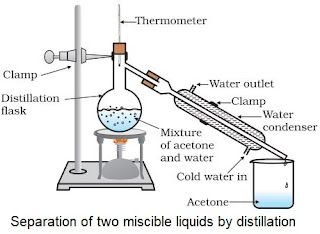
• Mixture of acetone and water is separated by this method.
Fractional distillation
• Fractional distillation is used to separate a mixture of two or more miscible liquids for which the
difference in boiling points is less than 25 K.
• Air is a homogeneous mixture and can be separated into its components by fractional distillation
Below is diagram which shows the steps of separation of air:
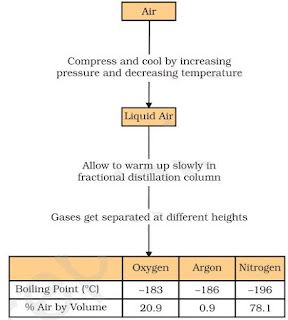
• The air is compressed by increasing the pressure and is then cooled by decreasing the temperature to get liquid air.
• The liquid air is warm-up slowly in a fractional distillation column, where gases get separated
different heights depending upon their boiling points.
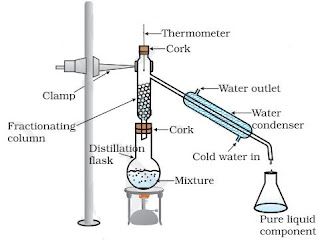
• It used to separate a gas from the air.
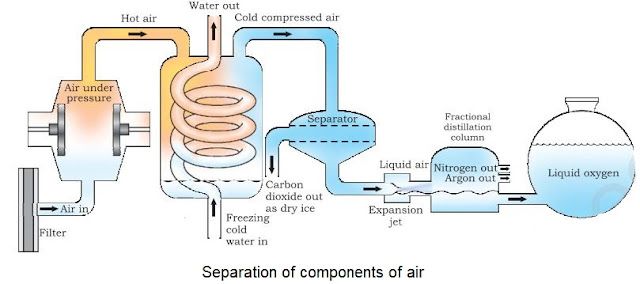
Crystallization
• Used to remove impurities from solid and purify it.
• It separates a pure solid from mixture in the form of crystals.
• This process is used in purification of salt from sea water, separation of crystals of alum from
impure samples.
• It is better method than evaporation because:
(i) Solids decompose or some, like sugar, may get charred on heating to dryness.
(ii) Some impurities may remain dissolved in the solution even after filtration. On evaporation the
contaminate the solid.

PHYSICAL & CHEMICAL CHANGES
- Books Name
- Science Made Easy Science Book
- Publication
- Science Made Easy
- Course
- CBSE Class 9
- Subject
- Science
Physical and Chemical changes
• The process which brings about changes in physical properties and no new substances are formed are physical changes. The common physical changes are changes in colour, hardness,rigidity, fluidity, density, melting point, boiling point etc.
• The process in which new Free substances are formed and chemical changed are chemical changes. Some chemical properties are odour, inflammability etc.
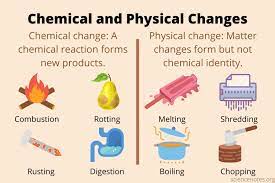
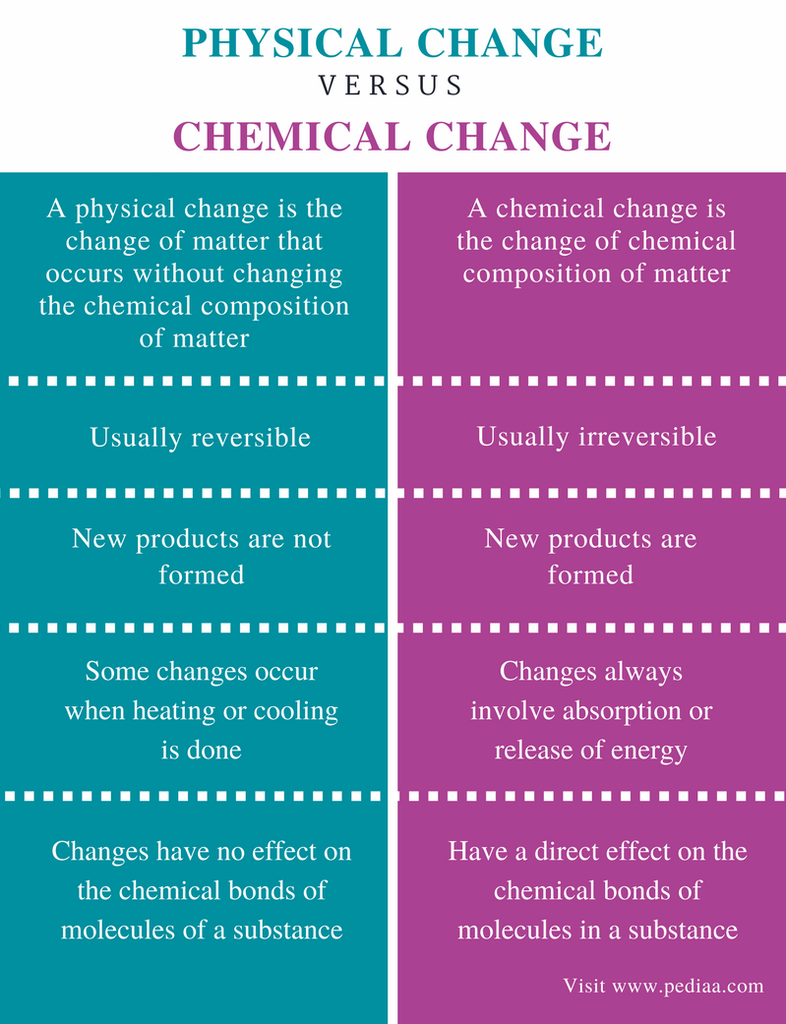
PURE SUBSTANCES AND ITS TYPES
- Books Name
- Science Made Easy Science Book
- Publication
- Science Made Easy
- Course
- CBSE Class 9
- Subject
- Science
Types of pure substances
The pure substance is divided in two types on the basis of their chemical composition:
(i) Elements
(ii) Compounds
(i) Elements
• According to Antoine Laurent Lavoisier, element is a basic form of matter that cannot be broken
down into simpler substances by chemical reactions.
• It is divided in three types which are metals, non-metals and metalloids.
Properties of Metals
(i) They have a lustre (shine).
(ii) They have silvery-grey or golden-yellow colour.
(iii) They conduct heat and electricity.
(iv) They are ductile (can be drawn into wires).
(v) They are malleable (can be hammered into thin sheets).
(vi) They are sonorous (make a ringing sound when hit).
• Examples of metals are gold, silver, copper, iron, sodium, potassium etc.
• Mercury is the only metal that is liquid at room temperature.
Properties of non-metals
(i) They display a variety of colours.
(ii) They are poor conductors of heat and electricity.
(iii) They are not lustrous, sonorous or malleable.
• Examples of non-metals are hydrogen, oxygen, iodine, carbon (coal, coke), bromine, chlorine
Metalloids: Elements having intermediate properties between those of metals and non-metal
called metalloids. Examples are boron, silicon, germanium etc.
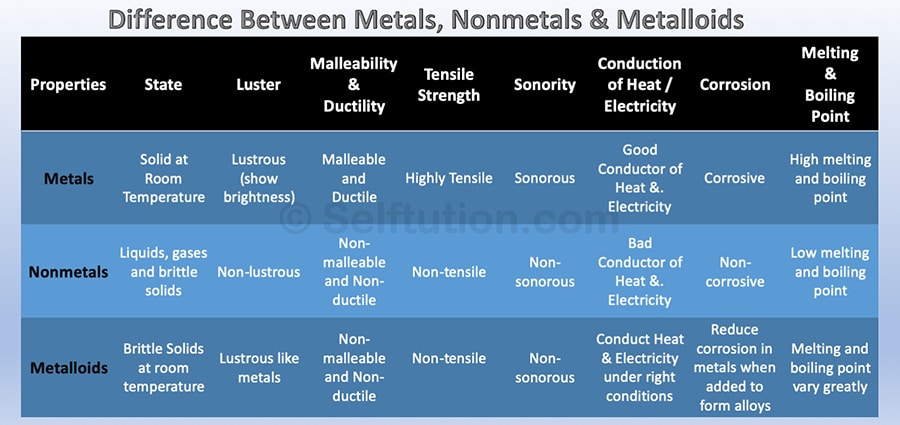
(ii) Compounds
A compound is a substance composed of two or more elements, chemically combined with oneanother in a fixed proportion.
Difference between mixtures and compounds
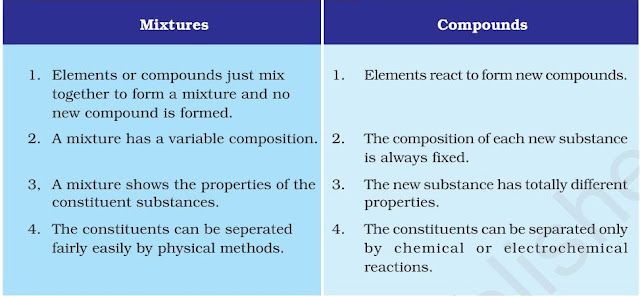

 Science Made Easy
Science Made Easy
 ACERISE INDIA
ACERISE INDIA
